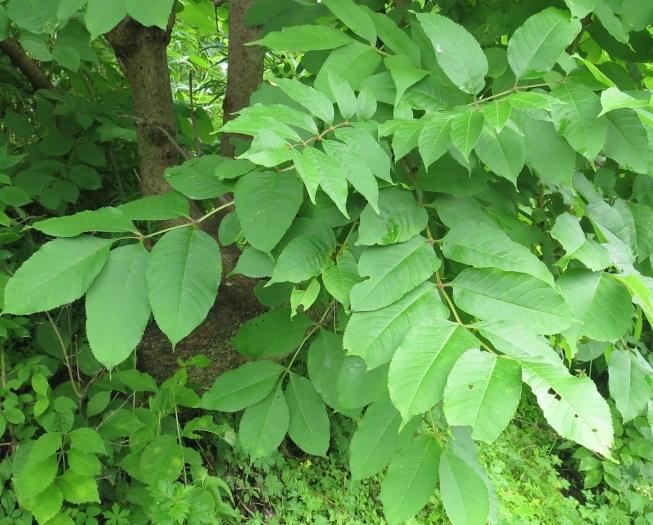Manchurian Ash
(Fraxinus mandshurica)
Manchurian Ash (Fraxinus mandshurica)
/
/

Repina Tatyana
CC BY 4.0
Image By:
Repina Tatyana
Recorded By:
Copyright:
CC BY 4.0
Copyright Notice:
Photo by: Repina Tatyana | License Type: CC BY 4.0 | License URL: http://creativecommons.org/licenses/by/4.0/ | Rights Holder: Repina Tatyana | Publisher: iNaturalist | Date Created: 2019-07-04T13:01:37-07:00 |
























Estimated Native Range
Summary
Fraxinus mandshurica, commonly known as Manchurian ash, is a deciduous tree native to mixed forests and riverbanks in northeastern Asia, including regions of China, Korea, Japan, and Russia. It can reach up to 98 feet (30 meters) in height, featuring a straight trunk and a full, rounded crown. The leaves are pinnate compound, typically comprising 5 to 7 leaflets, which turn a striking golden-yellow in the autumn, adding seasonal interest to the landscape. The Manchurian ash blooms with inconspicuous flowers that are wind-pollinated, followed by the production of samaras, a type of winged fruit that aids in seed dispersal.
This species is valued for its hardy nature and attractive fall coloration. It is used in reforestation projects, as an ornamental tree in parks and large gardens, and for its timber, which is used in furniture making and other wood products. Manchurian ash prefers moist, well-drained soils and can tolerate a range of soil types, from acidic to alkaline. It grows best in full sun to partial shade. While generally low-maintenance, it can be susceptible to diseases such as ash dieback and pests like the emerald ash borer. Due to its potential invasiveness, it is important to consult local guidelines before planting Manchurian ash outside its native range to prevent ecological disruptions.CC BY-SA 4.0
This species is valued for its hardy nature and attractive fall coloration. It is used in reforestation projects, as an ornamental tree in parks and large gardens, and for its timber, which is used in furniture making and other wood products. Manchurian ash prefers moist, well-drained soils and can tolerate a range of soil types, from acidic to alkaline. It grows best in full sun to partial shade. While generally low-maintenance, it can be susceptible to diseases such as ash dieback and pests like the emerald ash borer. Due to its potential invasiveness, it is important to consult local guidelines before planting Manchurian ash outside its native range to prevent ecological disruptions.CC BY-SA 4.0
Plant Description
- Plant Type: Tree
- Height: 20-30 feet
- Width: 15-25 feet
- Growth Rate: Moderate
- Flower Color: N/A
- Flowering Season: Spring
- Leaf Retention: Deciduous
Growth Requirements
- Sun: Full Sun, Part Shade
- Water: Medium
- Drainage: Fast, Medium
Common Uses
Natural Habitat
native to mixed forests and riverbanks in northeastern Asia, including regions of China, Korea, Japan, and Russia
Other Names
Common Names: Japanese Ash , Korean Ash , Shui Qu Liu , Yachidamo
Scientific Names: Fraxinus mandshurica , Fraxinus elatior , Fraxinus elatior , Fraxinus excelsa , Fraxinus excelsissima , Fraxinus mammifera , Fraxinus mandshurica subsp. brevipedicellata , Fraxinus mandshurica var. japonica , Fraxinus nigra subsp. mandshurica , Fraxinus nigra var. mandshurica
GBIF Accepted Name: